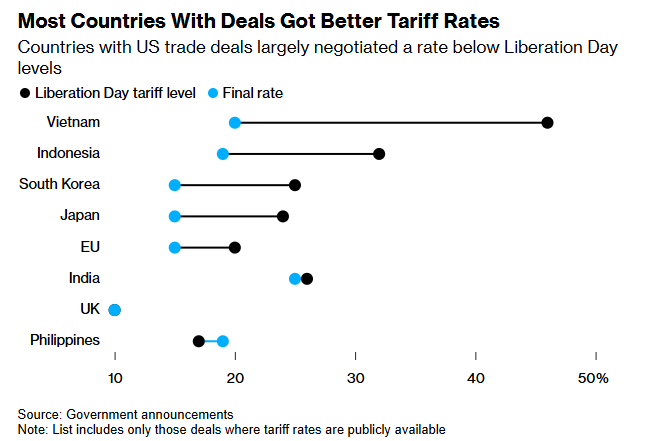Last-Minute Tariffs Before Trump's Deadline
Zhitong Caijing APP has noticed that Trump launched a series of tariff actions and demands on Friday, including unexpected measures against India and copper products. This US President is trying to establish a new global trade order.
On Wednesday, Trump announced a 15% tariff on Korean imports (matching the rate with neighboring Japan) and a punitive 25% tariff on Indian imports, criticizing its purchase of Russian energy and weapons and putting pressure on Prime Minister Narendra Modi. As Thailand and Cambodia agreed to stop fighting on Monday, this strengthened Trump's goal of shaping a global mediator image.
Malaysian Prime Minister Anwar Ibrahim revealed that Trump had informed him of tariff measures against Malaysia. "I hope the new tariffs will not have too big an impact on our country's economy," Anwar said to lawmakers. Trump also surprised the market with copper tariffs, after exempting 50% of mainstream transactions and creating a record-breaking drop in New York copper prices.
This tariff storm is taking place just before the August 1 deadline, when the White House previously threatened to impose equal tariffs on countries that fail to reach bilateral agreements - most countries have not reached agreements.
Trump claims that global tax rates will range from 15% to 50%, believing these policies can drive manufacturing back home, increase government revenue, and give him a huge bargaining chip over countries dependent on the US consumer market.
Rohan Subbaraman, chief economist at Nomura Holdings, said, "Today we're seeing the flood of details that matches the old saying: 'Don't see the forest for the trees.'" "Step back and look, Trump has basically fulfilled his tariff threat. The noise is just too loud."}

Most countries that have reached agreements have obtained more favorable tariff rates
The European stock market rose due to the bright financial reports of tech companies and optimistic sentiment in the US futures market, but the Asian stock market fell, with currency exchange rates reaching a two-month low.
Many countries have not yet reached trade agreements, while those that have reached agreements are still lacking key details - including potential exemption clauses, investment commitments, and changes to origin rules. As Trump's new trade order slowly unfolds, this uncertainty and chaos has impacted global economic growth and suppressed investment, despite market optimism.
Alicia García-Herrero, chief economist for Asia-Pacific at France's Natixis bank, said: "These agreements are all pushing forward - this is really not a good omen." She noted that this strong agreement will force countries to reach agreements to avoid higher tariffs, but may ultimately lead to greater economic losses for these countries.
The US-China relationship remains positive. Trump announced on Wednesday that the US would reach a "very fair" agreement with China.
Trade dynamics not only involve overseas. American consumers and small businesses will soon face higher transportation costs as Trump announces tariffs on goods worth $800 or less, starting from August 29. This type of goods was originally a blessing for consumers and retailers (many located in China), allowing products to be shipped directly.
Brazil's various products have unexpectedly received tariff exemptions, driving up its currency and stock market. Meanwhile, Bloomberg news reported that Trump will talk with Mexican President Claudia Sheinbaum on Thursday morning, which should boost Mexico's peso.
Canadian Prime Minister Mark Carney said on Wednesday that negotiations with the US may not be completed by Friday's deadline. After Trump tweeted that Canada supports Palestinian statehood, it became increasingly unlikely to reach a more favorable agreement.
The 15% tariff on Korean imports covers the automotive industry and includes a $3.5 billion investment plan (involving energy and shipbuilding) worth $3500 million. Trump said that these investments will be personally guided by him. Commerce Secretary Howard Lutnik said on X-Platform that 90% of the profits from the two countries' investment fund will return to the US.
Regarding India, Trump threatened to impose a 25% tariff on Indian imports and additional, yet unclear, punitive measures for its purchase of Russian energy. This will put pressure on various industries, including clothing and jewelry manufacturing.
Given that China also imports large amounts of Russian oil, any actions related to Russian oil may be mentioned in negotiations with China. Since 2022, Moscow has been a target of the US since its invasion of Ukraine. Oil prices maintained their near-six-month high levels on Thursday.
